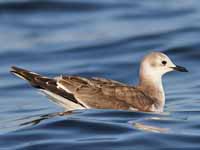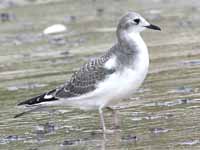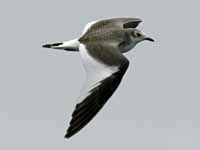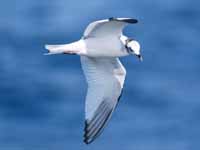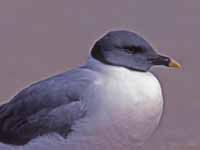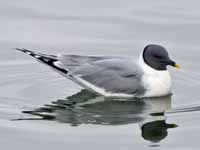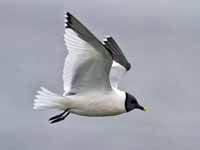THE WORLD BIRDS - An Online Bird Book
gullS and Allies
Gulls
Order Charadriiformes Family Laridae
gullS and Allies
Gulls, terns, skimmers, skuas, puffins, and their allies belong to the order Charadriiformes. Charadriiformes is a diverse order and contains many other families. Most live near water and eat invertebrates or other small animals, however, some are pelagic (seabirds), some occupy deserts and a few are found in thick forest.
Gulls
Order Charadriiformes Family Laridae
Gulls are most closely related to the terns, noddies, and skimmers. All of this group, except the terns, probably have ultraviolet vision as they have the SWS1 opsin gene. Gulls are typically medium to large birds, usually grey or white, often with black markings on the head or wings. They typically have harsh wailing or squawking calls, stout, longish bills, and webbed feet. gull species range in size from 29 to 76 cm. Most gulls, particularly Larus species, are ground nesting carnivores, which will take live food or scavenge opportunistically. Live food often includes crabs and small fish. gulls have unhinging jaws which allow them to consume large prey. Apart from the kittiwakes, gulls are typically coastal or inland species, rarely venturing far out to sea. large species take up to four years to attain full adult plumage, but two years is typical for small gulls. gulls are resourceful, inquisitive and intelligent birds, demonstrating complex methods of communication and a highly developed social structure.
Genus Chroicocephalus
These small to medium-sized gulls are omnivores eating insects, worms, fish,shrimp, mollusks, and garbage. They take 2 years to mature.
Gull,_Andean Chroicocephalus serranus
Description: The breeding Andean gull has a black head with white rear eye-arcs. The upperparts are grey, the neck and underparts are white. During breeding season, the head is mostly black with a white nape.Unusual for a gull, it breeds at high altitudes and thus should not be confused with other gulls. The similar brown-hood gull is only found rarely found at high altitudes. The Andean gull is 45 to 48 cm long.
Range: Along the Andes of western South America
Habitat: Breeding site is usually over 3000 ft. It moves lower in the winter and some make it to the coast.
Diet: Insects, worms, garbage. It can hawk flying insects.
Conservation status: Least Concern.
Image by: 1, 2) Charlie Westerinen - Lima Peru 3, 5, 6) Dick Daniels - Sacred Valley, Peru 4) Nick Athanas - Peru Range: Along the Andes of western South America
Habitat: Breeding site is usually over 3000 ft. It moves lower in the winter and some make it to the coast.
Diet: Insects, worms, garbage. It can hawk flying insects.
Conservation status: Least Concern.
1 - 3) Nonbreeding 4 - 6 breeding.
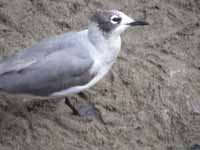
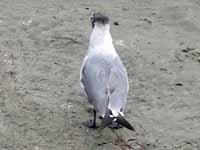




Gull,_Black-billed Chroicocephalus bulleri
Description: The black-billed gull is a lightly colored gull with a small amount of black on its wingtips. It has a long, thin, black bill with a bright red interior, reddish black feet, white eyes. The juvenile has a flesh colored bill with a dark tip and dark brown eyes. The black-billed gull is 35 to 38 cm long.
Range: New Zealand.
Habitat: Rives, lakes, farmland during breeding season; coast and estuaries other times.
Diet: Fish, insects, worms, garbage.
Conservation status: The black-billed gull is Near Threatened as the population is declining because of degradation of its breeding habitat.
Image by: 1, 2, 3) Dick Daniels - New ZealandRange: New Zealand.
Habitat: Rives, lakes, farmland during breeding season; coast and estuaries other times.
Diet: Fish, insects, worms, garbage.
Conservation status: The black-billed gull is Near Threatened as the population is declining because of degradation of its breeding habitat.
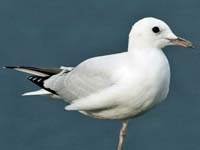
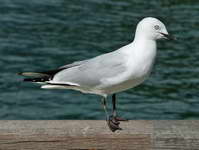
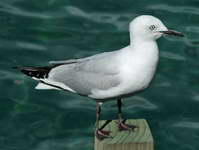
Gull,_Bonaparte's Chroicocephalus philadelphia
Description: The breeding Bonaparte's gull has a black head, short thin black bill, pale grey back and upper wings, white underparts, white neck, and orange legs. In winter the head is white except for small black patch behind the ear coverts. The similar black-headed gull has a dark red bill. The Bonaparte's gull is 28 to 30 cm long.
Range: North America.
Habitat: Breeds in the interior in bogs, marshes pond islands. Winters along both coasts and also the Great Lakes.
Diet: Mainly insects during breeding season. Other times fish, insects, mollusks, worms.
Conservation status: Least Concern.
Image by: 1, 2, 3) Dick Daniels - North Carolina 4) Dick - Mississippi 5) Jamie Chavez - California 6) Ken Schneider - Alaska Range: North America.
Habitat: Breeds in the interior in bogs, marshes pond islands. Winters along both coasts and also the Great Lakes.
Diet: Mainly insects during breeding season. Other times fish, insects, mollusks, worms.
Conservation status: Least Concern.
1 - 4) Nonbreeding 5, 6) Breedings

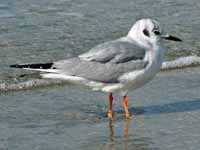
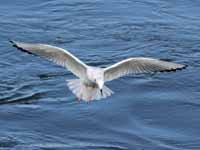
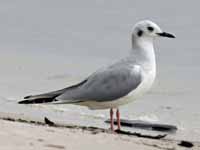

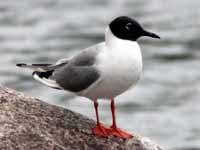
Gull,_Black-headed Chroicocephalus ridibundus Found: North America (northeastern), Europe
Description: The breeding black-headed gull has a dark brown head, red bill and legs, and pale grey upper wings with black-tipped primary feathers. It has white underparts, neck, and shoulders. In winter the head is white except for 2 dark black patches. It has white around the rear of the eyes. The black-headed gull is up to 44 cm long. The similar Bonaparte's gull has a black bill. The little gull has no white around the eyes.
Range: Mainly Europe, Asia; also eastern Canada, northern Africa.
Habitat: Coast waters or near lakes and rivers.
Diet: Insects, shrimp, worms, fish; also garbage.
Conservation status: Least Concern.
Image by: 1) Asten - London 2) Ómar Runólfsson - Iceland 3) Dick Daniels - North Carolina 4) Dick - Scotland 5) Maarten Van Kleinwee - Netherlands 6) Andy_Li Range: Mainly Europe, Asia; also eastern Canada, northern Africa.
Habitat: Coast waters or near lakes and rivers.
Diet: Insects, shrimp, worms, fish; also garbage.
Conservation status: Least Concern.
1, 2, 3) Nonbreeding 4 - 6) Breeding
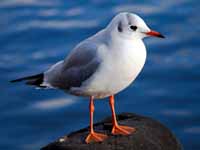
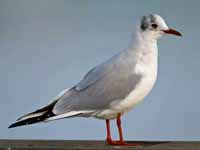
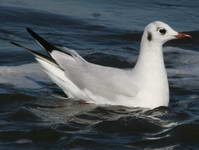

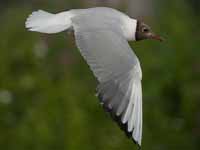
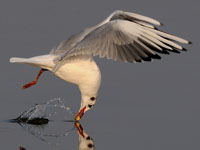
Gull,_Brown-headed Chroicocephalus brunnicephalus
Description: The breeding brown-headed gull has a brown head, pale grey upperparts, white neck, white underparts, red bill, and red legs. The nonbreeding hood is replaced by brown vertical stripes. It has incomplete white eye-rings. The brown-headed gull is up to 45 cm long.
Range: Asia.
Habitat: Breeds in the high plateaus of central Asia from Turkmenistan to Mongolia. It is migratory, wintering on the coasts and large inland lakes of tropical southern Asia.
Diet: Mainly fish when available. Also shrimp, insects, worms, garbage.
Conservation status: Least Concern.
Image by: 1) Ariful Haque Bhuiyan - Bangladesh 2) Gaurika Wijeratne 3) Mvshreeram - India 4) David Cook - Sri Lanka Range: Asia.
Habitat: Breeds in the high plateaus of central Asia from Turkmenistan to Mongolia. It is migratory, wintering on the coasts and large inland lakes of tropical southern Asia.
Diet: Mainly fish when available. Also shrimp, insects, worms, garbage.
Conservation status: Least Concern.
10 Juvenile 2) Nonbreeding 3, 4) Breeding
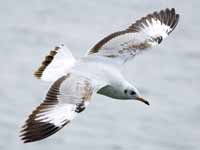

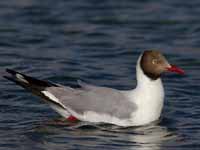
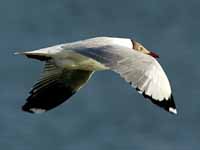
Gull,_Brown-hooded Chroicocephalus maculipennis Found: South America
Description: The breeding brown-hooded gull has a brown hood, grey wing tops with white outer primaries, black tips of inner primaries, and a red bill. It has a white neck, shoulders, and underparts. There is an incomplete white eye-ring. The nonbreeding adult has a white head with a dark spot behind ear-coverts. The similar Andean gull is not found at the coast while the larger brown-hood gull rarely found at high altitudes.
Range: Coastal South America below the equator; also interior Argentina, Patagonia, Uruguay.
Habitat: Freshwater lakes, intertidal marshes, river banks, and open fields.
Diet: Mainly nsects. Also crabs, clams, carrion, garbage.
Conservation status: Least Concern.
Image by: 1, 4) Cláudio Timm - Brazil 2) payayita - Argentina 3) Nick Athanas - ArgentinaRange: Coastal South America below the equator; also interior Argentina, Patagonia, Uruguay.
Habitat: Freshwater lakes, intertidal marshes, river banks, and open fields.
Diet: Mainly nsects. Also crabs, clams, carrion, garbage.
Conservation status: Least Concern.
1) Nonbreed 2 - 4) Breeding
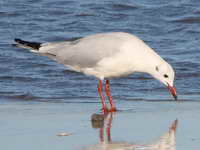
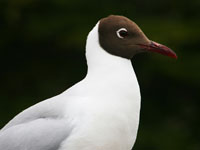


Gull,_Grey-hooded Chroicocephalus cirrocephalus
Description: The breeding grey-hooded gull, aka the grey-headed gull, has a light grey hood and also most of the upperparts. It has white shoulders, neck, and underparts. The bill and legs are red; the underwings are dark grey with white wing-tips. In the winter it has a white head with a faint mark behind the ears. The grey-hooded gull is up to 43 cm long. The similar black-headed gull has a darker hood. Hartlaub's gull has darker eyes and legs.
Range: South America, Africa.
Habitat: Mainly the coast and estuaries.
Diet: Fish, invertebrates, insects, garbage. It can catch insects in the air and even plunge dive for prey.
Conservation status: Least Concern.
Image by: 1) Johann Snyman - South Africa 2) John B - New York (very infrequent in USA) 3) Nik_Borrow - Uganda 4) Gabriel
Buissart 5) Lip Key - South Africa 6) Cláudio Timm - Brazil Range: South America, Africa.
Habitat: Mainly the coast and estuaries.
Diet: Fish, invertebrates, insects, garbage. It can catch insects in the air and even plunge dive for prey.
Conservation status: Least Concern.
1, 2) Nonbreeding

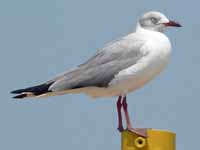
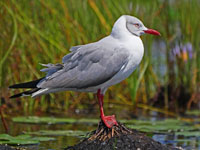
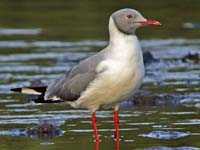
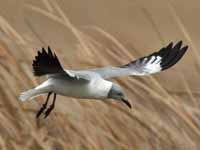
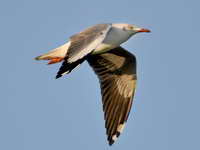
Gull,_Hartlaub's Chroicocephalus hartlaubii
Description: The Hartlaub's gull is mainly a white gull with a grey back and upper-wings. It has black wingtips with conspicuous white "mirrors", and a dark red bill plus legs. When breeding it has a very faint grey hood, but otherwise has a plain white head. The Hartlaub's gull is 36 to 38 cm long. It takes 2 years to reach maturity. The similar grey-hooded gull. Breeding grey-hooded gull has distinct hood plus lighter eyes and legs.
Range: South Africa, Namibia.
Habitat: Near the coast and estuaries.
Diet: Fish, invertebrates, insects, garbage. It can catch insects in the air and even plunge dive for prey.
Conservation status: Least Concern.
Image by: 1,
2, 3) Dick- Cape Town, South Africa 4) Dick - Hout, South Africa Range: South Africa, Namibia.
Habitat: Near the coast and estuaries.
Diet: Fish, invertebrates, insects, garbage. It can catch insects in the air and even plunge dive for prey.
Conservation status: Least Concern.

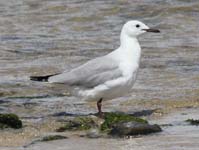


Gull,_Red-billed Chroicocephalus novaehollandiae scopulinus
Description: The red-billed gull used to be considered a separate species, but is now treated as a subspecies of the silver gull. It is a fairly small gull with an all red bill, red eye-ring, red legs and feet. The eyes are white. It has pale grey wings with black wingtips; the rest of the plumage is white. Juveniles have brown legs and a dark brown bill making them had to tell from the black-billed gull.
Range: New Zealand.
Habitat: Coastal and inland, especially garbage areas.
Diet: Fish, invertebrates, insects, garbage, seeds, berries.
Conservation status: Least Concern.
Image by: 1, 2, 3, 4) Tony
Wills in Petone, Wellington,
Range: New Zealand.
Habitat: Coastal and inland, especially garbage areas.
Diet: Fish, invertebrates, insects, garbage, seeds, berries.
Conservation status: Least Concern.
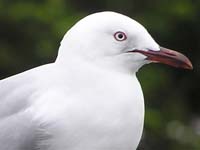
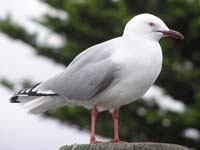
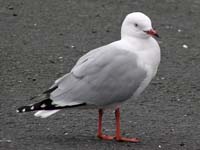
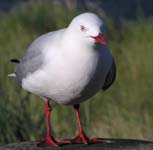
Gull,_Silver Chroicocephalus novaehollandiae
Description: The silver gull has a white body, head, and tail. It has light grey wings with black tips terminated in white. The bill and legs are red. The silver gull is 40 to 45 cm long.
Range: Australia and New Zealand.
Habitat: Coastal and inland, especially garbage areas.
Diet: Fish, invertebrates, insects, garbage, seeds, berries.
Conservation status: Least Concern.
Image by: 1) Charlie Westerinen - Australia 2) Dick Daniels - Australia 3) JJ Harrison - Tasmania 4) Nik_BorrowRange: Australia and New Zealand.
Habitat: Coastal and inland, especially garbage areas.
Diet: Fish, invertebrates, insects, garbage, seeds, berries.
Conservation status: Least Concern.
1) Juvenile and adult
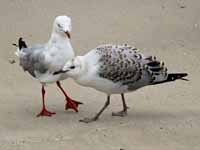
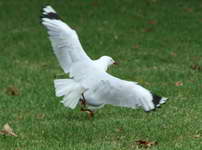
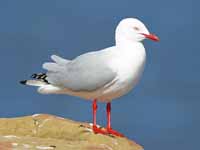
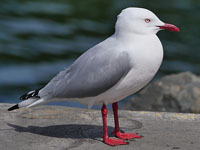
Gull,_Slender-billed Chroicocephalus genei
Description: The slender-billed gull has a slender and slight drooping reddish-black bill. It has dark red legs and a grey back with grey wings The head, neck, and underparts are white. It has a pale yellow iris. Breeding birds have a pink-tinged breast. The slender-billed gull is 37 to 40 cm long.
Range: Europe, Asia, Africa. It breeds mainly around the Mediterrean and north of the western Indian Ocean; winters further south in Afica and India.
Habitat: Lagoons and lakes in breeding season; estuaries and bays otherwise.
Diet: Fish, aquatic invertebrates, insects some of which are captured in the air; infrequently garbage.
Conservation status: Least Concern.
Image by: 1, 4) Lip Kee - Egypt 2) Gabriel Buissart 3) Nik_Borrow - SenegalRange: Europe, Asia, Africa. It breeds mainly around the Mediterrean and north of the western Indian Ocean; winters further south in Afica and India.
Habitat: Lagoons and lakes in breeding season; estuaries and bays otherwise.
Diet: Fish, aquatic invertebrates, insects some of which are captured in the air; infrequently garbage.
Conservation status: Least Concern.

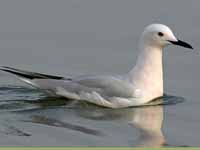
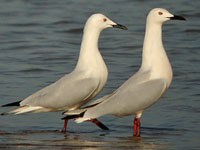
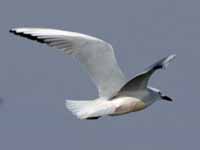
Genus Creagrus- 1 species
Gull,_Swallow-tailed Creagrus furcatus
Description: The swallow-tailed gull has a white swallow-shaped tail, grey back, wings that are black near the back, white further out, and black wingtips. The bill is black with a white tip. The breeding gull has a black head and red eye-ring while the nonbreeding gull has a white head and black eye-ring. The swallow-tailed gull has proportionally large eyes which yields good night vision.
Range: West coast of South America; breeds in the vicinity of Galapagos Islands.
Habitat: Pelagic.
Diet: Fish and squid which are captured mostiy at night.
Conservation status: Least Concern.
Image by: 1) David Cook - Galapagos 2) Nick Athanas 3,4) Benjamint444 Range: West coast of South America; breeds in the vicinity of Galapagos Islands.
Habitat: Pelagic.
Diet: Fish and squid which are captured mostiy at night.
Conservation status: Least Concern.
1, 2) Juvenile
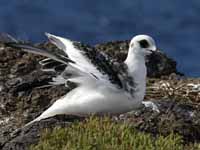
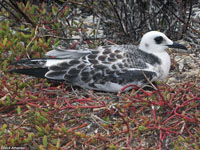
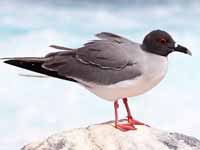
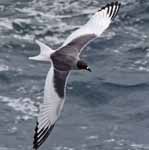
Genus Hydrocoloeus - 1 species
Gull,_Little Hydrocoloeus minutus
Description: The little gull is the smallest gull with a length of less than 30 cm. It has light grey, back, wings, and pale underwings. The shoulders, neck, and underparts are white. It has has small dark red bill and red legs. While breeding it has ablack hood and residual black spots on the head when not breeding.The breeding little gull does not have white around the eyes which helps identify it from the black-headed gull and also Bonaparte's gull. Black-headed gull and Bonaparte's gull have white around the eye, Little gull does not. The similar Sabine's gull has ac yellow tipped bill.
Range: Europe, Asia; also rarely on the Candaian east coast.
Habitat: Breeds inland near water. Other times found in coast waters.
Diet: Fish, flying insects .
Conservation status: Least Concern.
Image by: 1) Kallerna - Finland 2) Ómar Runólfsson - Iceland 3) Andrej_Chudy 4) Ekaterina ChernetsovaRange: Europe, Asia; also rarely on the Candaian east coast.
Habitat: Breeds inland near water. Other times found in coast waters.
Diet: Fish, flying insects .
Conservation status: Least Concern.
1) Nonbreding 3, 4) Breeding
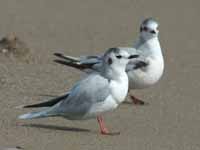
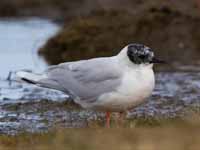
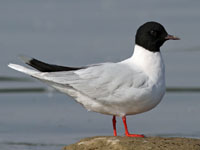

Genus Ichthyaetus
Gull,_Audouin's Ichthyaetus audouinii
Description: The Audouin's gull has a grey back and wings. The head, neck, and underparts are white; the bill red with a black ring; the legs grey-green. The folded tail is black with white spots. The Audouin's gull is a large gull, up to 52 cm long.
Range: The Mediterranean of Europe, Asia, and Africa. Also the northwestern Atlantic coast of Africa.
Habitat: Coastal.
Diet: Mainly fish. It is not a scavenger.
Conservation status: It is listed as Vulnerable with a population of 10,000, but that is up from1000 in the 60's.
Image by: 1, 2) Nik_Borrow - Spain 3) Andreas Butz 4) Sergey Yeliseev - SpainRange: The Mediterranean of Europe, Asia, and Africa. Also the northwestern Atlantic coast of Africa.
Habitat: Coastal.
Diet: Mainly fish. It is not a scavenger.
Conservation status: It is listed as Vulnerable with a population of 10,000, but that is up from1000 in the 60's.
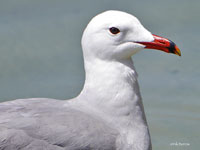
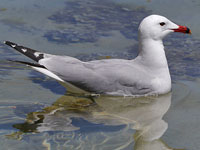
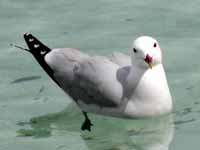
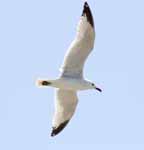
Gull,_Mediterranean Ichthyaetus melanocephalus Found: Europe, Asia, Africa
Description: The breeding Mediterranean gull has a very pale grey mantle and wings. The primary feathers are white. It has a black hood, white forehead, white eye crescents, and a dark red bill with black subterminal band. The non breeding adult is similar but the hood is reduced to an extensive dusky mask through the eyes. It also has white eye crescents. The Mediterranean gull is 36 t0 38 cm long.
Range: Previously restricted to near the Mediterranean and Black Sea. Now also along the eastern Atlantic coast.
Habitat: Near coasts.
Diet: Fish, worms, insects, garbage.
Conservation status: Least Concern.
Image by: 1) Charlie Westerinen - Hungary 2) Agustin_Povedano 3) Stefan_Berndtsson 4) Martin Olsson - Sweden Range: Previously restricted to near the Mediterranean and Black Sea. Now also along the eastern Atlantic coast.
Habitat: Near coasts.
Diet: Fish, worms, insects, garbage.
Conservation status: Least Concern.
1) Juvenile 2) Nonbreeding 3, 4) Breeding
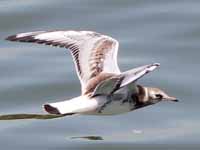
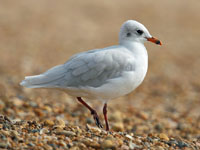
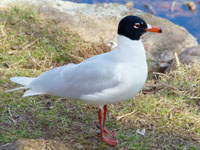
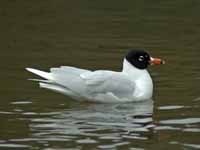
Gull,_Pallas's Ichthyaetus ichthyaetus
Description: The breeding Pallas's gull has a black head, grey back, and mainly grey wings with black ends and white tips. The bill is red with a black ring and the legs are yellow. Non breeding Phallas's gullls have some black on head and a white forehead. This is a large gull with a length of up to 72 cm. they are not social.
Range: Mainly Asia; also Europe and Africa. Breeds in colonies in marshes and islands from southern Russia to Mongolia; winters in the eastern Mediterranean, Arabia and India.
Habitat: Coasts, large rivers.
Diet: Mainly fish and crustaceans. Also insects and small animals.
Conservation status: Least Concern.
Image by: 1) Imran_Shah - Pakistan 2, 3) Balaji Venkatesh Sivaramakrishnan 4) Ron KnightRange: Mainly Asia; also Europe and Africa. Breeds in colonies in marshes and islands from southern Russia to Mongolia; winters in the eastern Mediterranean, Arabia and India.
Habitat: Coasts, large rivers.
Diet: Mainly fish and crustaceans. Also insects and small animals.
Conservation status: Least Concern.
1) Nonbreeding
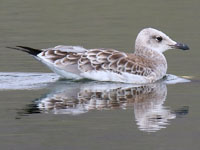
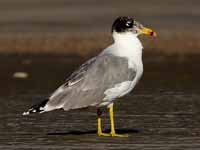

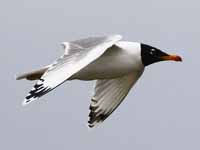
Gull,_Relict Ichthyaetus relictus
Description: The nonbreeding relict gull, aka the Central Asia gull, has dark-smudged ear-coverts and streaks on rear hind-crown. Breeding has black hood, nape, grey-brown forehead, white half-moon shapes around eye, red legs, scarlet bill. relict gull is up to 45 cm long.
Range: Breeds in central Asia, winters on Pacific east coast of Asia.
Habitat: Breeds on water bodies in arid areas. Decreasing water levels appears to be reducing population. Winters near coastal mudflats.
Diet: Insects, small fish.
Conservation status: It is listed as Vulnerable with a decreasing population of under 10,000.
Image by: 1) Tom_Beeke - China 2) LonelyShrimp - ChinaRange: Breeds in central Asia, winters on Pacific east coast of Asia.
Habitat: Breeds on water bodies in arid areas. Decreasing water levels appears to be reducing population. Winters near coastal mudflats.
Diet: Insects, small fish.
Conservation status: It is listed as Vulnerable with a decreasing population of under 10,000.
1) Nonbreeding 2) Breeding

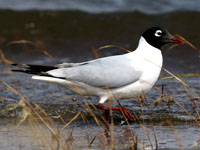
Gull,_Sooty Ichthyaetus hemprichii
Description: the sooty gull has greyish-brown mantle, wings, hood, and breast. There is a white half collar on the nape. The belly is white. It has a grey bill with dark band and red tip.
Range: Red Sea, east coast of Africa, the Persian Gulf and its range extends as far east as Pakistan.
Habitat: Mainly coastal.
Diet: Small fish, prawns, eggs, chicks, dead fish.
Conservation status: Least Concern.
Iage by: 1) Baresi_franco 2, 3) S Jahanmi 4) Moayed Bahajjaj - OmanRange: Red Sea, east coast of Africa, the Persian Gulf and its range extends as far east as Pakistan.
Habitat: Mainly coastal.
Diet: Small fish, prawns, eggs, chicks, dead fish.
Conservation status: Least Concern.
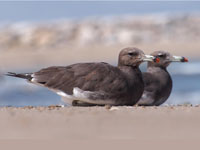
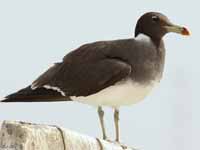
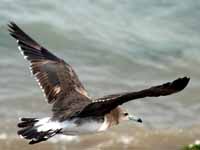
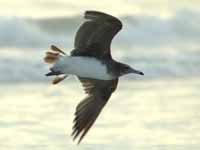
Gull,_White-eyed Ichthyaetus leucophthalmus
Description: The white-eyed gull has a long slender bill which is dark for juveniles and deep red with a black tip for adults., medium dark grey upperparts, light grey breast, and a white belly. It has white eye-arcs which leads to its name. The breeding gull has a black head and throat. In the nonbreeding gull these areas are white speckled with the black. The white-eyed gull is up to 43 cm long.
Range: Asia and Africa in the vicinity of the Red Sea.
Habitat: Breeds on islands; widespread over the Red Sea the rest of the year.
Diet: Mainly fish; also scavengers, especially at dumps.
Conservation status: The white-eyed gull is listed as Least Concern
Image by: 1) Sergey Yeliseev - Egypt 1, 2, 3) Marcel Holyoak - IsraelRange: Asia and Africa in the vicinity of the Red Sea.
Habitat: Breeds on islands; widespread over the Red Sea the rest of the year.
Diet: Mainly fish; also scavengers, especially at dumps.
Conservation status: The white-eyed gull is listed as Least Concern
2, 3, 4) Breeding

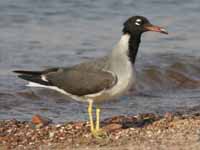
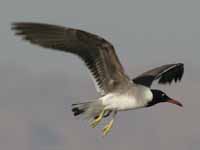
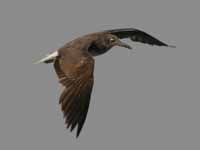
Genus Larus
The Larus gulls are in general medium to large birds, typically grey or white, often with black markings on the head or wings. They have stout, longish bills and webbed feet.
Gull,_Armenian Larus armenicus Found: Europe, Asia, Africa
The Armenian gull has grey back and wing-tops, white underparts, head, neck, tail, yellow legs, yellow bill with dark ring, dark eyes. Some primary wing feathers have white spots (mirrors) at tips. First winter birds are mainly brown.
Found in the Caucasus and Middle East.
Similar to: Ring-billed gull. Ranges do not overlap. Armenian gull has dark eyes, Ring-billed gull has yellow eyes.
Similar to: Yellow-legged gull. Armenian gull has dark eyes, Yellow-legged gull has yellow eyes.
Description:
Range: xxx.
Habitat: xxx.
Diet: xxx.
Conservation status: Least Concern.
Image by: 1, 2, 3, 4) Marcel Holyoak - IsraelFound in the Caucasus and Middle East.
Similar to: Ring-billed gull. Ranges do not overlap. Armenian gull has dark eyes, Ring-billed gull has yellow eyes.
Similar to: Yellow-legged gull. Armenian gull has dark eyes, Yellow-legged gull has yellow eyes.
Description:
Range: xxx.
Habitat: xxx.
Diet: xxx.
Conservation status: Least Concern.
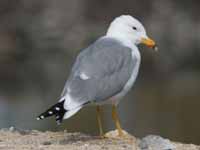
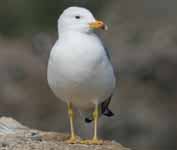
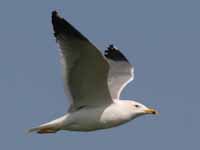
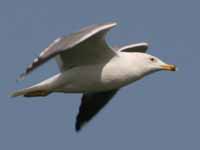
Gull,_Belcher's also Band-tailed gull Larus belcheri Found: South America
The breeding Belcher's gull has black back and wing-tops, white underparts, head, neck, yellow legs, yellow bill - red and black spot at its end. Nonbreeding has black head, white eye crescents, dark tipped bill. Top surface of tail is banded - white in front, black at end. Primary wing feathers no not have white spots (mirrors) at tips.
Similar to: Kelp gull. Kelp gull has white spots on tip of primaries, Belcher's gull has entirely black wing tips. Kelp gull has all white tail. Belcher's gull has black tail-band.
Similar to: Olrog's gull. Olrog's gull is on the Atlantic coast of South America and Belcher's is on the Pacific Coast of South America.
Description:
Range: xxx.
Habitat: xxx.
Diet: xxx.
Conservation status: Least Concern.
Image by: 1, 3) Charlie Westerinen - Lima, Peru 2, 4) Nick Athanas - Peru 5) Alastair Rae 6) Dick Daniels - LimaSimilar to: Kelp gull. Kelp gull has white spots on tip of primaries, Belcher's gull has entirely black wing tips. Kelp gull has all white tail. Belcher's gull has black tail-band.
Similar to: Olrog's gull. Olrog's gull is on the Atlantic coast of South America and Belcher's is on the Pacific Coast of South America.
Description:
Range: xxx.
Habitat: xxx.
Diet: xxx.
Conservation status: Least Concern.
1, 2) Juvenile 3, 4) Nonbreeding 5, 6) Breeding

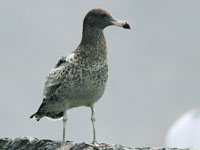
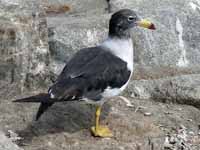
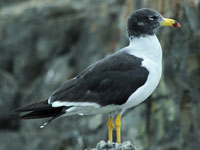


Gull,_Black-tailed Larus crassirostris Found: North America (rare), east Asia
The breeding Black-tailed gull has grey back and wing-tops, white underparts, head, neck, white tail with a black band and white-tipped end, yellow legs, yellow bill with red and black spot at end, yellow eyes with red orbital ring. Some primary wing feathers have white spots (mirrors) at tips. Nonbreeding adult has brown streaked head.
Similar to: Ring-billed gull. Ring of Black-tailed gull is close to the end of its bill, ring of Ring-billed gull is not close to the end of its bill. Tip of Black-tailed gull's bill is red. Their ranges rarely overlap.
Description:
Range: xxx.
Habitat: xxx.
Diet: xxx.
Conservation status: Least Concern.
Image by: 1) Andy Li 2) Kevin Lin - Taiwan 3) Osa Mu - Japan 4) Angie - Japan 5) Alistair Rae - Japan 6) Shizhao - Bejing Zoo 7) Bamse on ferry across Tokyo baySimilar to: Ring-billed gull. Ring of Black-tailed gull is close to the end of its bill, ring of Ring-billed gull is not close to the end of its bill. Tip of Black-tailed gull's bill is red. Their ranges rarely overlap.
Description:
Range: xxx.
Habitat: xxx.
Diet: xxx.
Conservation status: Least Concern.
1, 2) Juvenile
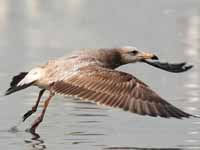
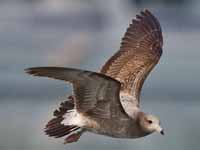
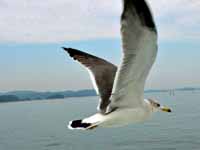
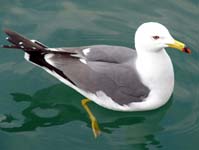
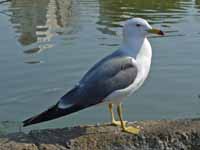
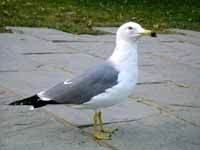
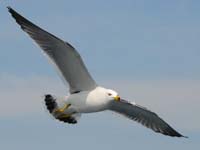
Gull,_California Larus californicus Found: west North America
The breeding California gull has grey back and wing-tops, white underparts, head, neck, tail, yellow-green legs, yellow bill with red and black at end, dark eyes with red orbital ring. Some primary wing feathers have white spots (mirrors) at tips. Nonbreeding adult has sooty streaks on nape
Similar to Herring gull. California gull has a darker iris. Herring gull has pink legs, California gull has yellowish-green legs.
Similar to: Ring-billed gull. California gull is larger and has a darker iris. Ring-billed gull has a more distinct ring on bill.
Description:
Range: xxx.
Habitat: xxx.
Diet: xxx.
Conservation status: Least Concern.
Image by: 1) Laura Gooch - Washington 2, 4) Elaine R Wilson - Near Victoria, British Columbia 3) Dick Daniels - California 5) Len Blumin - California 6) Maggie Smith 7) Charlie Westerinen - UtahSimilar to Herring gull. California gull has a darker iris. Herring gull has pink legs, California gull has yellowish-green legs.
Similar to: Ring-billed gull. California gull is larger and has a darker iris. Ring-billed gull has a more distinct ring on bill.
Description:
Range: xxx.
Habitat: xxx.
Diet: xxx.
Conservation status: Least Concern.
1, 2) Juvenile 3, 4) Nonbreeding 5, 6, 7) Breeding
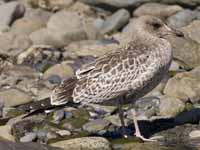

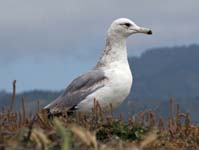
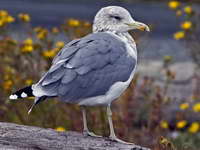
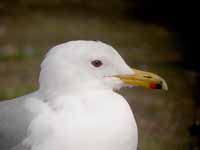

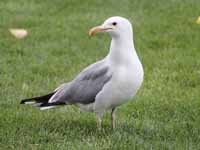
Gull,_Cape Larus vetula Found: southern Africa
The Cape gull has black upperparts, wings black on top with white spots on tip of primaries, wings white below with black near ends, white underparts, head, neck, tail, yellow bill with red spot, dark eye.
Similar to: Kelp gull. Considered by some to be species of Kelp gull. The ranges do not overlap. Cape gull has a darker eye than Kelp gull.
Image by: 1) Lip Kee 2) Dick Daniels - George, South Africa 3, 4) Dick - Hout, South Africa 5) Dick - Plettenberg Bay, South AfricaSimilar to: Kelp gull. Considered by some to be species of Kelp gull. The ranges do not overlap. Cape gull has a darker eye than Kelp gull.
1) Juvenile
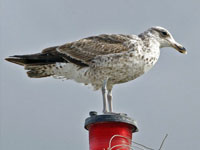

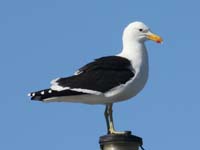
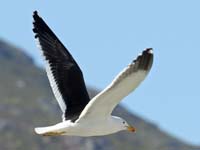
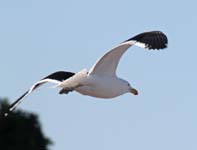
Gull,_Caspian Larus cachinnans Found: east Europe, west and central Asia
Breeds in eastern Europe and west/central Asia. Range extends westward after breeding season. The legs are normally pink at all ages, but can be yellowish.
Similar to: Herring gull. Easiest way to differentiate between the species is by range.
Similar to: Yellow-legged gull. The leg color of adult Yellow-legged gulls is usually sufficient to differentiate Yellow-legged gulls from Caspian gulls, but the legs of their species can also occassionally be yellowish. Range can also be used to differentiate between the species.
Image by: 1) Marek Szczepanek 2) Luciano 95 3) Jan_Svetlik 4) Nik_Borrow - England 5, 6) Maarten van KleinweeSimilar to: Herring gull. Easiest way to differentiate between the species is by range.
Similar to: Yellow-legged gull. The leg color of adult Yellow-legged gulls is usually sufficient to differentiate Yellow-legged gulls from Caspian gulls, but the legs of their species can also occassionally be yellowish. Range can also be used to differentiate between the species.
1, 2) Juvenile 3 - 6) Adult


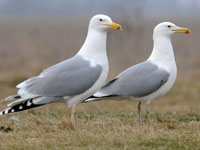
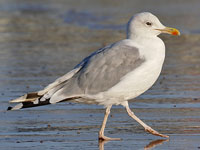
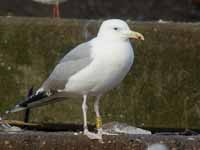
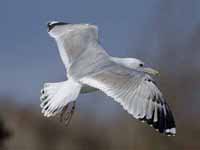
Gull,_Glaucous Larus hyperboreus Found: North America, Europe, Asia
The breeding Glaucous gull has grey back and wing-tops, white underparts, head, neck, tail, pink legs, yellow bill with red spot, yellow eyes with yellow orbital ring, sometimes red ring. White primary wing feathers. Nonbreeding adult has slightly streaked head.
Similar to: Glauscous-winged gull. Juvenile Glaucous gull has light colored bill with dark tip, juvenile Glaucous-winged gull has dark bill. Adult Glaucous gull has bright eye and a yellow gape at the base of its bill, adult Glaucous-winged gull has dark eye and pink gape.
Similar to: Iceland gull. Glaucous gull much larger than Iceland gull.
Image by: 1) Ómar Runólfsson - Iceland 2) Nik_Borrow 3) Linda Tanner - California 4) Len Blumin - California 5) Agustin_Povedano - Spain 6) Alastair Rae - Japan 7) nebirdsplus - New Hampshire 8) US Fish and Wildlife Service - Aleutian Islands 9) Blake Maybank - California Similar to: Glauscous-winged gull. Juvenile Glaucous gull has light colored bill with dark tip, juvenile Glaucous-winged gull has dark bill. Adult Glaucous gull has bright eye and a yellow gape at the base of its bill, adult Glaucous-winged gull has dark eye and pink gape.
Similar to: Iceland gull. Glaucous gull much larger than Iceland gull.
1, 2) Juvenile, dark type 3, 4, 5) Juvenile 6) Adult, nonbreeding 7, 8, 9) Adult, breeding
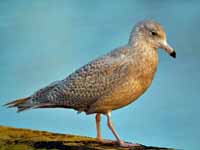
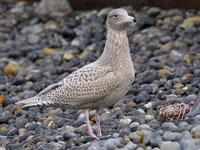
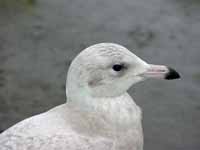
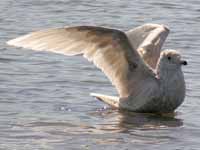
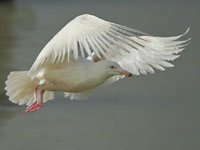
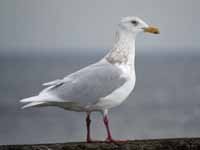
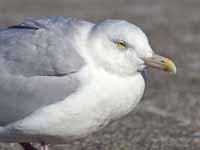
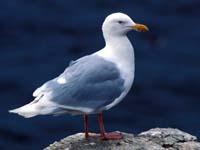
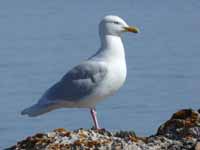
Gull,_Glaucous-winged Larus glaucescens Found: North America (Pacific Coast)
The breeding Glaucous-winged gull has grey back and wing-tops, white underparts, head, neck, tail, pink legs, yellow bill with red spot, dark eyes with pink orbital ring. Nonbreeding adult has lightly speckled brown neck.
Similar to: Glauscous gull. Juvenile Glaucous gull has light colored bill with dark tip, juvenile Glaucous-winged gull has dark bill. Adult Glaucous gull has bright eye and a yellow gape at the base of its bill, adult Glaucous-winged gull has dark eye and pink gape.
Similar to: Iceland gull.
Image by: 1) Just Chaos 2, 3, 6) Dick Daniels - Seldovia, Alaska 4) tgreyfox 5) Dick Daniels - Seward, Alaska Similar to: Glauscous gull. Juvenile Glaucous gull has light colored bill with dark tip, juvenile Glaucous-winged gull has dark bill. Adult Glaucous gull has bright eye and a yellow gape at the base of its bill, adult Glaucous-winged gull has dark eye and pink gape.
Similar to: Iceland gull.
1, 2, 3) Juvenile 4) 3rd winter 5. 6) Breeding
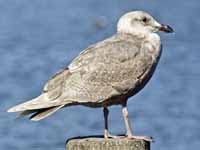

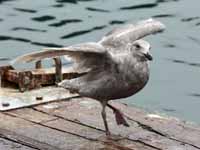
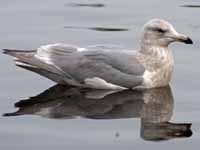

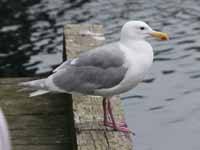
Gull,_Great Black-backed Larus marinus Found: east North America, Europe, Asia
The adult Great Black-backed gull has black back and wing-tops, white underparts, head, neck, tail, pink legs, yellow bill with red spot. Some primary wing feathers have white spots (mirrors) at tips. This is the world's largest gull.
Similar to: Lesser Black-backed gull. Adult Lesser Black-backed has yellow legs, adult Great Black-backed gull has pink legs. Great Black-backed gull is considerably larger. Juvenile Lesser Black-backed has smaller bill and more streaks on breast than Great Black-backed. When not flying, juvenile LBBG has more solid dark brown visible on rump than GBBG.
Similar to: Kelp Gull, Slaty-backed gull. Of these gulls, only the Great Black-backed has pink legs.
Image by: 1, 2, 3, 4, 5, 6, 7, 8, 9, 10, 11) Dick DanielsSimilar to: Lesser Black-backed gull. Adult Lesser Black-backed has yellow legs, adult Great Black-backed gull has pink legs. Great Black-backed gull is considerably larger. Juvenile Lesser Black-backed has smaller bill and more streaks on breast than Great Black-backed. When not flying, juvenile LBBG has more solid dark brown visible on rump than GBBG.
Similar to: Kelp Gull, Slaty-backed gull. Of these gulls, only the Great Black-backed has pink legs.
1 - 5) Juvenile
10) Great Black-Backed gull is larger than Herring gull
11) Back: adult Herring gull and 2 adult Great Black Backs.
Middle: juvenile Lesser Black Backed and juvenile Great Black Backed.
Front: juvenile Herring gull.
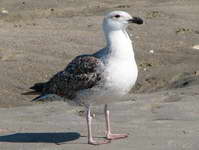
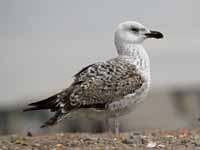
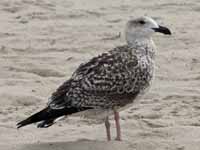
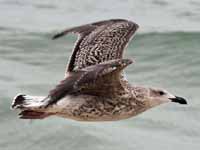

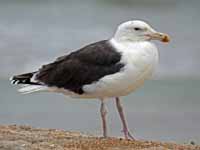

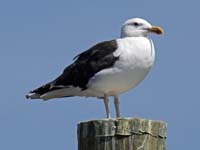
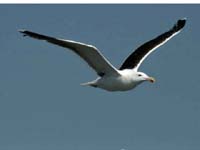
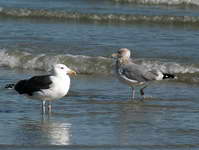
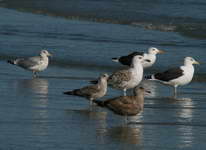
Gull,_Heermann's Larus heermanni Found: North America and Central America
The Heermann's gull has grey body, blackish-grey wings and tail with white edges, red bill with black tip, white head in summer, dusky grey in winter.
Not similar to any other gull.
Image by: 2, 3, 4, 7, 8, 9. 10, 11) Dick Daniels - California 5, 12) Alan D Wilson - Huntington Beach, California 6) Elaine R. Wilson - La Jolla, CaliforniaNot similar to any other gull.
2, 3, 4) Juvenile 5, 6, 7) non breeding 8 - 11) breeding
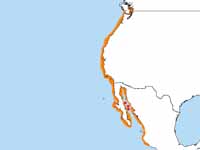

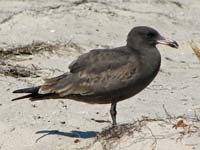
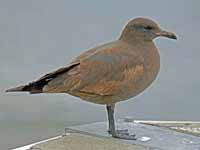
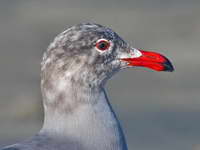

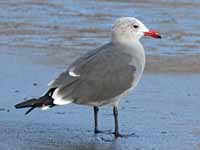
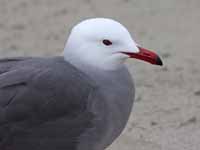

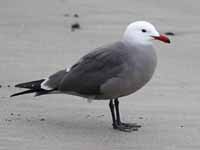
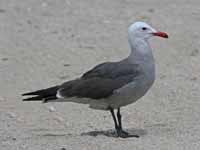
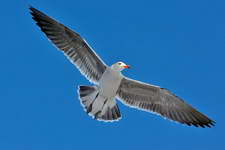
Gull,_ Herring (American) Larus smithsonianus Found: North America, Asia
The breeding American Herring gull has grey back and wing-tops, white underparts, head, neck, tail, pink legs, yellow bill with red spot, yellow eyes with orange orbital ring. Some primary wing feathers have white spots (mirrors) at tips. Nonbreeding adult has brown speckled head and neck.
Similar to Califoria gull. California gull has a darker iris. Herring gull has pink legs, California gull has yellowish-green legs.
Similar to: European Herring Gull, Some consider the America Herring gull to be a subspecies of the European. Diffiicult to distingquish between them.
Similar to: Slaty-backed Gull, juvenile. Juvenile Herring gulls and juvenile Slaty-backed gulls are difficult to distinguish. Adult Herring gull has a lighter back than Adult Slaty-backed gull.
Similar to: Thayer's gull. Herring gulls are darker than Thayer's gull. Adult Herring gull has yellow eye, Thayer's gull has dark eye.
Similar to: Western Gull, juvenile. Juvenile Herring gull and juvenile Western gull difficult to distinguish.
Image by: 1, 2, 3, 4, 5, 6, 7, 8, 9, 10) Dick Daniels - East Coast, United States Similar to Califoria gull. California gull has a darker iris. Herring gull has pink legs, California gull has yellowish-green legs.
Similar to: European Herring Gull, Some consider the America Herring gull to be a subspecies of the European. Diffiicult to distingquish between them.
Similar to: Slaty-backed Gull, juvenile. Juvenile Herring gulls and juvenile Slaty-backed gulls are difficult to distinguish. Adult Herring gull has a lighter back than Adult Slaty-backed gull.
Similar to: Thayer's gull. Herring gulls are darker than Thayer's gull. Adult Herring gull has yellow eye, Thayer's gull has dark eye.
Similar to: Western Gull, juvenile. Juvenile Herring gull and juvenile Western gull difficult to distinguish.
1 - 4) Juvenile 5) Juvenile, adult 6) nonbreeding 7, 8,,9, 10) Breeding
9) The concentric circles of waves were caused by the gull rapidly stomping its feet to help find prey. As it stomped its feet it also slowly rotated in a circle.
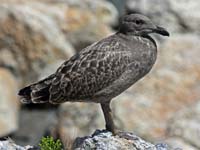
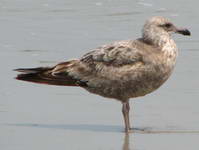
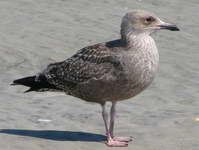
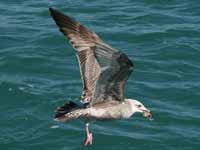
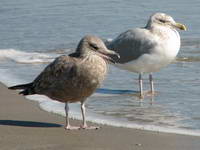
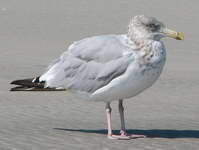
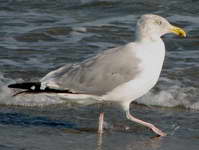
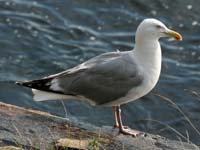

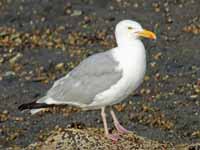
Gull,_ Herring (European) Larus argentatus Found: northern Europe (Great Britain, the North Sea coast, and Scandinavia), Asia
The breeding European Herring gull has grey back and wing-tops, white underparts, head, neck, tail, pink legs, yellow bill with red spot, yellow eyes with orange orbital ring. Some primary wing feathers have white spots (mirrors) at tips. Nonbreeding adult has brown speckled head and neck.
Similar to: American Herring Gull, Some consider the America Herring gull to be a subspecies of the European. Diffiicult to distingquish between them.
Similar to: Caspian gull. Easiest way to differentiate between the species is by range.
Similar to: Yellow-legged gull. The leg color of adult Yellow-legged gulls is usually sufficient to differentiate Yellow-legged gulls from either Herring gulls, but the legs of these species can occassionally be yellowish. Range can also be used to differentiate between the species.
Image by: 1, 3, 4) Dick Daniels - England 2) Charlie Westerinen - Lerwick , Shetland Island 5) Jalil Arfaoui Similar to: American Herring Gull, Some consider the America Herring gull to be a subspecies of the European. Diffiicult to distingquish between them.
Similar to: Caspian gull. Easiest way to differentiate between the species is by range.
Similar to: Yellow-legged gull. The leg color of adult Yellow-legged gulls is usually sufficient to differentiate Yellow-legged gulls from either Herring gulls, but the legs of these species can occassionally be yellowish. Range can also be used to differentiate between the species.
1) Juvenile

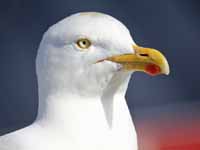
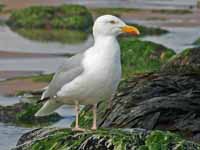
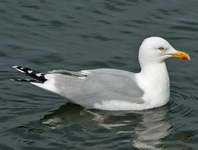

Gull,_Iceland Larus glaucoides Found: northeast North America to north Europe
The adult Iceland gull has light grey back and wing-tops, white underparts, head, neck, tail, pink legs, yellow bill with red spot. Sometimes primary wing feathers have black spots at tips.
Similar to: Glaucous Gull, Glauscous-winged gull. Glaucous gull much larger than Iceland gull.
Similar to: Thayer's gull. Thayer's gull usually darker than Iceland gull. Adult Thayer's gull has more black on wing-tips than adult Iceland gull.
Image by: 1) Mpf -
Northumberland, UK 2) Len Blumin - California 3) Mdf - Toronto, CA 4) Hillary Chambers 5) Ómar Runólfsson - Iceland 7) Seabamirum - New York Similar to: Glaucous Gull, Glauscous-winged gull. Glaucous gull much larger than Iceland gull.
Similar to: Thayer's gull. Thayer's gull usually darker than Iceland gull. Adult Thayer's gull has more black on wing-tips than adult Iceland gull.
1 - 4) Juvenile 2) L. g. kumlieni 5) Adult, nonbreeding 6) Adult, breeding
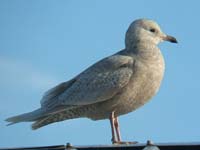
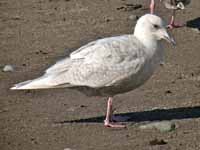
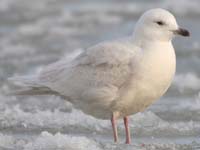
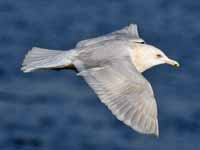
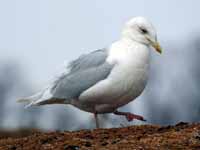
Gull,_Kelp also Southern Black-backed gull Larus dominicanus Found: North America (rare), South America, Africa, Australasia
The adult Kelp gull has black back and wing-tops, white underparts, head, neck, tail, greenish-yellow legs, yellow bill with red spot. Some primary wing feathers have white spots (mirrors) at tips.
Similar to: Belcher's gull. Kelp gull has white spots on tip of primaries, Belcher's gull has entirely black wing tips. Kelp gull has all white tail, Belcher's gull has black tail-band.
Similar to: Cape gull. Considered by some to be species of Kelp gull. The ranges do not overlap. Cape gull has a darker eye than Kelp gull.
Similar to: Great Black-backed gull. Great Black-backed gull has pink legs, Kelp gull has greenish-yellow legs (more yellow when breeding).
Similar to: Lesser Black-back gull. Adult Lesser Black-backed gulls have brighter yellow feet than Kelp gulls.
Similar to: Yellow-footed gull. Adults are easliy differentiated because of the Yellow-footed gull's bright yellow feet.
Image by: 1) dFaulder - Isla Magdalena, Chile 2, 4, 5) Dick Daniels -
New Zealand 3) Dick - Chile 6, 9) Charlie Westrinen - Antarctic region 7) Cláudio Timm Beagle Channel, Argentina 8) Dario
Sanches - BrazilSimilar to: Belcher's gull. Kelp gull has white spots on tip of primaries, Belcher's gull has entirely black wing tips. Kelp gull has all white tail, Belcher's gull has black tail-band.
Similar to: Cape gull. Considered by some to be species of Kelp gull. The ranges do not overlap. Cape gull has a darker eye than Kelp gull.
Similar to: Great Black-backed gull. Great Black-backed gull has pink legs, Kelp gull has greenish-yellow legs (more yellow when breeding).
Similar to: Lesser Black-back gull. Adult Lesser Black-backed gulls have brighter yellow feet than Kelp gulls.
Similar to: Yellow-footed gull. Adults are easliy differentiated because of the Yellow-footed gull's bright yellow feet.
1) Adult, chick 2, 3) Juvenile 4 - 7) Adult 6, 9) L. d. austrinusus
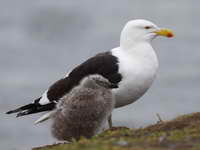


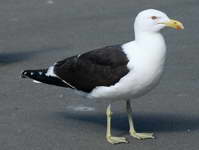
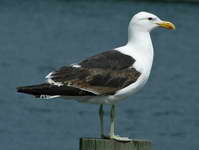
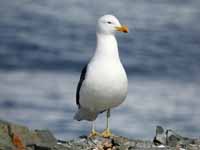

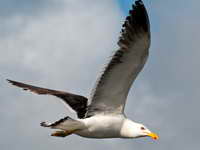
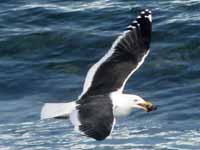
Gull,_Lesser Black-backed Larus fuscus Found: east North America, South America (rare), Europe, Asia, Africa
The adult Lesser Black-backed gull has black back and wing-tops, white underparts, head, neck, tail, bright yellow legs, yellow bill with red spot. Some primary wing feathers have white spots (mirrors) at tips.
Similar to: Great Black-backed gull. Adult Lesser Black-backed has yellow legs, adult Great Black-backed gull has pink legs. Great Black-backed gull is considerably larger. Juvenile Lesser Black-backed has smaller bill and more streaks on breast than Great Black-backed. When not flying, juvenile LBBG has more solid dark brown visible on rump than GBBG.
Similar to: Kelp gull. Adult Lesser Black-backed gulls have brighter yellow feet then Kelp gulls.
Similar to: Yellow-footed gull. Adult Lesser Black-backed gull and adult Yellow-footed gull both have yellow feet. Their rnages do not overlap.
Similar to: Yellow-legged gull. Adults of both species have yellow legs, but the back of Lesser Black-backed gull is much darker than that of Yellow-legged gull.
Image by: 1, 3) Dick Daniels - Nantucket, Massachusetts 2) Mark Skevington - England 4) Grantuking - Portugal 5, 7, 8, 9)
Dick - Scotland 6) Maarten van Kleinwee - Netherlands Similar to: Great Black-backed gull. Adult Lesser Black-backed has yellow legs, adult Great Black-backed gull has pink legs. Great Black-backed gull is considerably larger. Juvenile Lesser Black-backed has smaller bill and more streaks on breast than Great Black-backed. When not flying, juvenile LBBG has more solid dark brown visible on rump than GBBG.
Similar to: Kelp gull. Adult Lesser Black-backed gulls have brighter yellow feet then Kelp gulls.
Similar to: Yellow-footed gull. Adult Lesser Black-backed gull and adult Yellow-footed gull both have yellow feet. Their rnages do not overlap.
Similar to: Yellow-legged gull. Adults of both species have yellow legs, but the back of Lesser Black-backed gull is much darker than that of Yellow-legged gull.
1, 2, 3) Juvenile 3) Lesser Black-backed gull is smaller than Herring gull 4) Adult, nonbreeding 5 - 9) Adult, breeding
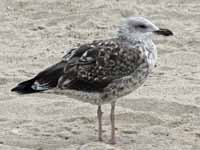
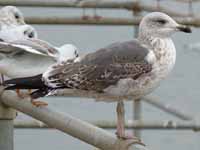
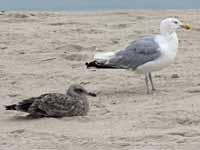
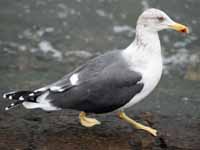
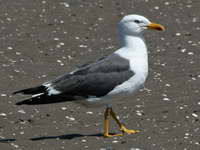
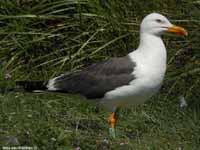
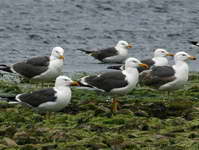
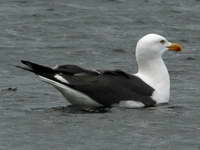
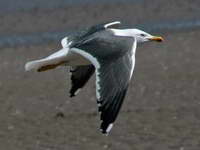
Gull,_Mew also Common gull Larus canus Found: west North America, Europe, Asia, north Africa
The breeding Mew has grey back and wing-tops, white underparts, head, neck, tail, greenish-yellow, yellow bill, yellow eyes with red orbital ring. Some primary wing feathers have white spots (mirrors) at tips. Nonbreeding adult has neck streaked with grey, hint of dark ring at end of bill.
Similar to: Ring-billed gull. Ringed-bill gull has a distinct ring on the bill, Mew gull has at most an indistinct ring. Mew gull has dark eyes, Ringed-bill has light eyes. Mew gull slightly smaller than Ring-billed gulls and on the average the bill is shorter.
Image by: 1) Alan Wilson - Alaska 2) Alan D. Wilson - British Columbia 3) Dick Daniels - Half Moon Bay, California 4, 5, 6, 7) Dick - Homer, Alaska 8, 9, 10) Dick - Denali National Park, Alaska Similar to: Ring-billed gull. Ringed-bill gull has a distinct ring on the bill, Mew gull has at most an indistinct ring. Mew gull has dark eyes, Ringed-bill has light eyes. Mew gull slightly smaller than Ring-billed gulls and on the average the bill is shorter.
1) Juvenile 2 - 5) Nonbreeding 6 - 10) Breeding
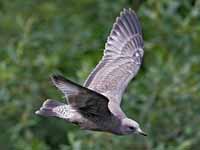
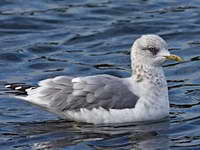
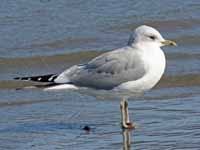
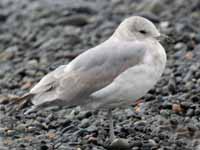
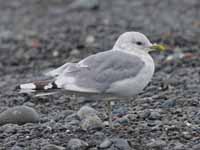
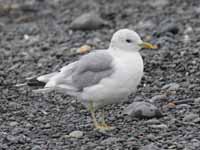
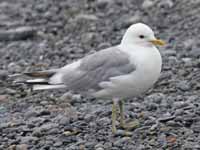

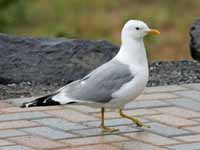
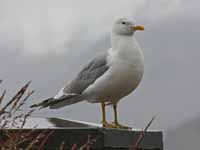
Eurasian
Image: 1, 2, 3, 6) Dick - Scotland 3) Dick - Scotland 4) Keith Marshall - England 5) Sergey Yeliseev - Moscow region 7) Charles Lam - Korea
1) Juvenile 2) Common gull in front, Herring gull in back 7) Identified by Ville Supponen
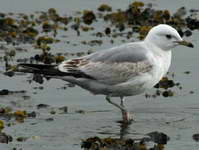
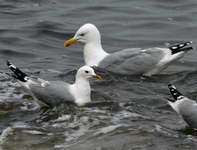

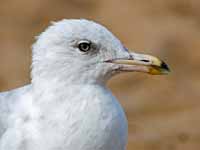
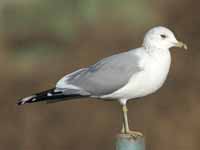
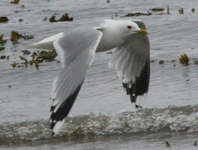
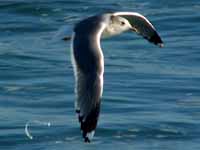
Gull,_Olrog's Larus Atlanticus Found: Atlantic coast of South America
The breeding Olrog's gull has black back and wing-tops, white underparts, head, neck, white tail black-tipped, yellow legs, yellow bill - red and black spot at its end. Primary wing feathers no not have white spots (mirrors) at tips.
Similar to: Belcher's gull. Olrog's gull is on the Atlantic coast of South America and Belcher's is on the Pacific Coast of South America.
Image by: 1, 2, 3) Cláudio Timm - Rio Grande do Sul, Brazil 4) Cristiano Crolle - Las Gaviotas, ArgentinaSimilar to: Belcher's gull. Olrog's gull is on the Atlantic coast of South America and Belcher's is on the Pacific Coast of South America.
1, 2) Juvenile
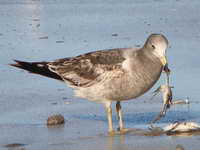
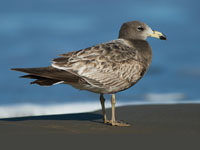
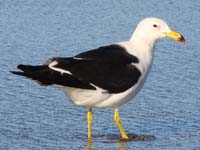
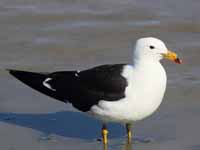
Gull,_Pacific Larus pacificus Found: Australia
The adult Pacific gull has black back and wing-tops, white underparts, head, neck, white tail with black band and white-tipped, dark yellow legs, yellow bill with red tip, pale iris with orange orbital ring. Primary wing feathers no not have white spots (mirrors) at tips.
Similar to: Kelp gull. The adult Pacific gull has dark yellow legs compared to the greenish-yellow of the Kelp gull.
Image by: 1) Dick Daniels - Featherdale Wildlife Park in Australia 2) melbournian1 - Sandringham beach
3) Nik_Borrow 4) Chensiyuan - Melbourne 5) Charlie Westerinen - Syndey, Australia 6) Ron_Knight - TasmaniaSimilar to: Kelp gull. The adult Pacific gull has dark yellow legs compared to the greenish-yellow of the Kelp gull.
1) Juvenile
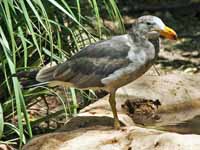
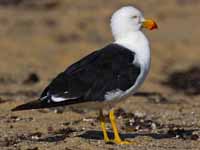

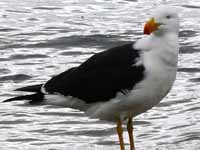
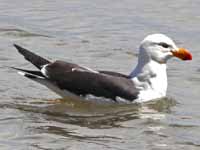
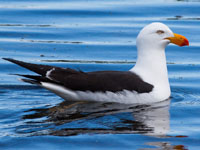
Gull,_Ring-billed Larus delawarensis Found: North America, Europe
The breeding Ring-billed gull has grey back and wing-tops, white underparts, head, neck, tail, yellow legs, yellow bill with dark ring, yellow eyes with red orbital ring. Some primary wing feathers have white spots (mirrors) at tips. Nonbreeding adult has brown streaked head.
Similar to: Armenian gull. Ranges do not overlap. Armenian gull has dark eyes, Ring-billed gull has yellow eyes.
Similar to: Black-tailed gull. Ring of Black-tailed gull is close to the end of its bill, ring of Ring-billed gull is not close to the end of its bill. Tip of Black-tailed gull's bill is red. Their ranges rarely overlap.
Similar to: California gull. California gull is larger and has a darker iris. Ring-billed gull has a more distinct ring on bill.
Similar to: Common gull / Mew gull. Ringed-bill gull has a distinct ring on the bill, Common gull has at most an indistinct ring. Common gull has dark eyes, Ringed-bill has light eyes. Common gull slightly smaller than Ring-billed gulls and on the average the bill is shorter.
Image by: 1) Mdf - Ontario 2, 3, 4, 5, 6, 7, 8, 9, 10, 11, 12) Dick Daniels - North Carolina Similar to: Armenian gull. Ranges do not overlap. Armenian gull has dark eyes, Ring-billed gull has yellow eyes.
Similar to: Black-tailed gull. Ring of Black-tailed gull is close to the end of its bill, ring of Ring-billed gull is not close to the end of its bill. Tip of Black-tailed gull's bill is red. Their ranges rarely overlap.
Similar to: California gull. California gull is larger and has a darker iris. Ring-billed gull has a more distinct ring on bill.
Similar to: Common gull / Mew gull. Ringed-bill gull has a distinct ring on the bill, Common gull has at most an indistinct ring. Common gull has dark eyes, Ringed-bill has light eyes. Common gull slightly smaller than Ring-billed gulls and on the average the bill is shorter.
1) Juvenile 2, 3) Immature 4, 5, 6) Nonbreeding 9. 10) Breeding

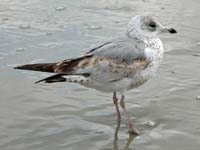
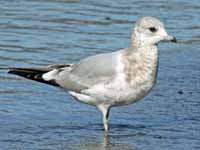
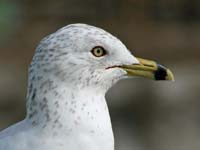
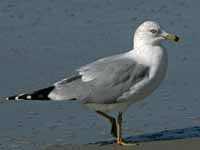
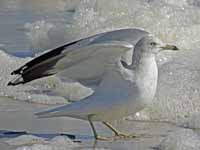
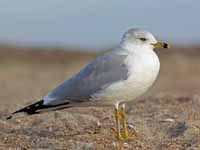
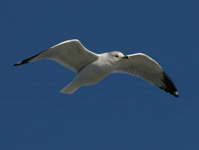
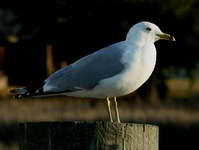
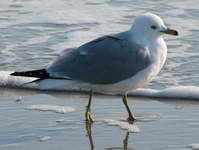
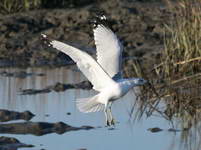

Gull,_Slaty-backed Larus schistisagus Found: North America (infrequent), eastern coast of Asia
The breeding Slaty-backed gull has dark grey back and wing-tops, white underparts, head, neck, tail, pink legs, yellow bill with red spot, yellowish eyes with pinkish orbital ring. Some primary wing feathers have white spots (mirrors) at tips. Nonbreeding adult has marked head and nape.
Similar to: Herring Gull, juvenile. Juvenile Herring gulls and juvenile Slaty-backed gulls are difficult to distinguish.
Similar to: Western gull. Slaty-backed gull has slightly darker wings and back, thinner bill. Nonbreeding adult Western gull has whiter head and neck than nonbreeding Slaty-backed gull.
Image by: 1) Charles Lem 2) Hiyashi Halso 3) Herman Mays - Japan 4) E-190 5) Seabamirum - New YorkSimilar to: Herring Gull, juvenile. Juvenile Herring gulls and juvenile Slaty-backed gulls are difficult to distinguish.
Similar to: Western gull. Slaty-backed gull has slightly darker wings and back, thinner bill. Nonbreeding adult Western gull has whiter head and neck than nonbreeding Slaty-backed gull.
1) Juvenile 2, 3) Adult, nonbreeding 4) Adult, breeding
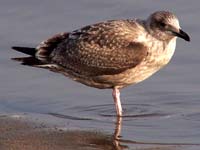
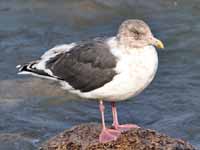

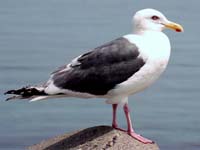
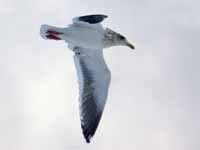
Gull,_Thayer's Larus thayeri Found: North America
The breeding Thayer's gull has grey back and wing-tops, white underparts, head, neck, tail, pink legs, yellow bill with red spot, usually dark eyes. Wing bottom white with black tipped primaries. Nonbreeding adult has brown speckled head and neck, greenish-yellow bill.
Similar to: Herring gull. Herring gulls are darker than Thayer's gull. Adult Herring gull has yellow eye, Thayer's gull has dark eye.
Similar to: Iceland gull. Thayer's gulls are darker than Iceland gulls.
Image by: 1) Jorge Montejo - Mexico 2) Jerry Oldenettel - New Mexico
3) Maggie Smith - California 4) Nathan Hamm 5) Maholyoak - Monterey, California Similar to: Herring gull. Herring gulls are darker than Thayer's gull. Adult Herring gull has yellow eye, Thayer's gull has dark eye.
Similar to: Iceland gull. Thayer's gulls are darker than Iceland gulls.
1, 2, 3) Juvenile 5) Nonbreeding (front), breeding (rear)
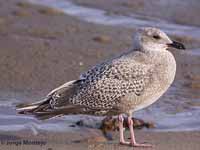
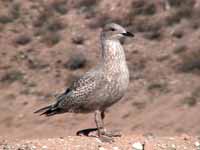
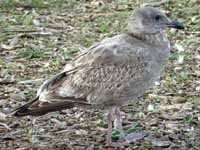
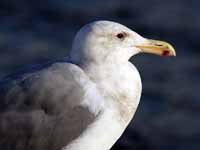
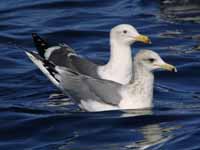
Gull,_Western Larus occidentalis Found: Pacific coast North America
The adult Western gull has dark grey back and wing-tops, white underparts, head, neck, tail, pink legs, yellow bill with red spot, eyes have orange-yellow orbital ring. Some primary wing feathers have white spots (mirrors) at tips.
Similar to: Herring Gull, juvenile. Juvenile Herring gull and juvenile Western gull difficult to distinguish.
Similar to: Slaty-backed gull. Slaty-backed gull has slightly darker wings and back, thinner bill. Nonbreeding adult Western gull has whiter head and neck than nonbreeding Slaty-backed gull.
Similar to: Yellow-footed gull. Adults are easliy differentiated because of the Yellow-footed gull's yellow feet.
Image by: 1) Basar - California 2, 4, 5, 6, 7, 8, 9) Dick Daniels - California 3) Lucina M 10) Nicholas D - Alaska Similar to: Herring Gull, juvenile. Juvenile Herring gull and juvenile Western gull difficult to distinguish.
Similar to: Slaty-backed gull. Slaty-backed gull has slightly darker wings and back, thinner bill. Nonbreeding adult Western gull has whiter head and neck than nonbreeding Slaty-backed gull.
Similar to: Yellow-footed gull. Adults are easliy differentiated because of the Yellow-footed gull's yellow feet.
1, 2) Juvenile
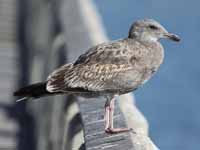
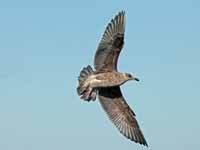
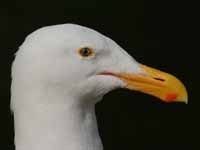
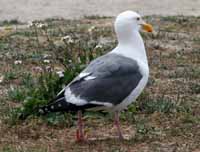
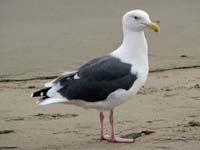
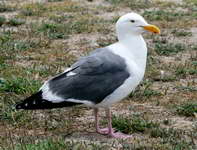
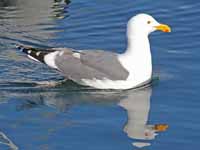
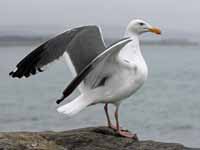
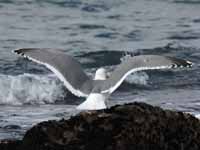
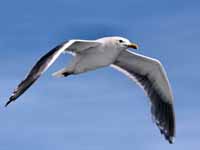
Gull,_Yellow-footed Larus livens Found: Pacific coast North America
The adult Yellow-footed gull has dark grey back and wing-tops, white underparts, head, neck, tail, bright yellow legs, yellow bill with red spot, yellow eyes with yellow orbital ring. Some primary wing feathers have white spots (mirrors) at tips.
Similar to: Kelp gull. Adults are easliy differentiated because of the Yellow-footed gull's bright yellow feet.
Similar to: Lesser-blacked gull. Adult Lesser Black-backed gull and adult Yellow-footed gull both have yellow feet. Their rnages do not overlap.
Similar to: Western gull. Adults are easliy differentiated because of the Yellow-footed gull's yellow feet.
Image by: 1, 3) Jerry Oldenettel - California 2) Amy McAndrews - Mexico 4) Steve Ryan Similar to: Kelp gull. Adults are easliy differentiated because of the Yellow-footed gull's bright yellow feet.
Similar to: Lesser-blacked gull. Adult Lesser Black-backed gull and adult Yellow-footed gull both have yellow feet. Their rnages do not overlap.
Similar to: Western gull. Adults are easliy differentiated because of the Yellow-footed gull's yellow feet.
1) Juvenile
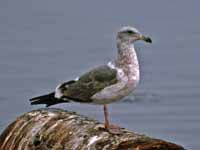
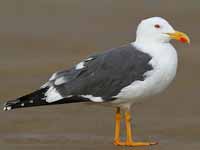
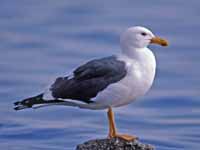
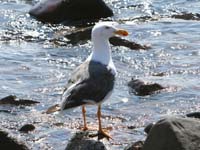
Gull,_Yellow-legged Larus michahellis Found: North America (rare), Europe , Africa
The breeding Yellow-footed gull has grey back and wing-tops, white underparts, head, neck, tail, yellow legs, yellow bill with red spot, yellow eyes with red orbital ring. Some primary wing feathers have white spots (mirrors) at tips. Nonbreeding adult may have some streaking on head.
Similar to: Arnenian gull. Armenian gull has dark eyes, Yellow-legged gull has yellow eyes.
Similar to: Caspian gull , Herring gull. The leg color of adult Yellow-legged gulls is usually sufficient to differentiate Yellow-legged gulls from either Herring or Caspian gulls, but the legs of these species can occassionally be yellowish. Range can also be used to differentiate between the species.
Similar to: Lesser Black-backed. Adults of both species have yellow legs, but the back of Lesser Black-backed gull is much darker than that of Yellow-legged gull.
Image by: 1) Jorg Hempel - Thasos, Greece 2) Julio
Reis - Porto, Portugal 3) Alvesgasper Similar to: Arnenian gull. Armenian gull has dark eyes, Yellow-legged gull has yellow eyes.
Similar to: Caspian gull , Herring gull. The leg color of adult Yellow-legged gulls is usually sufficient to differentiate Yellow-legged gulls from either Herring or Caspian gulls, but the legs of these species can occassionally be yellowish. Range can also be used to differentiate between the species.
Similar to: Lesser Black-backed. Adults of both species have yellow legs, but the back of Lesser Black-backed gull is much darker than that of Yellow-legged gull.
4) Sergey Yeliseev - Turkey 5) Frankie Chu 6) Charlie Westerinen - Hamburg, Germany 7) Video by Avibirds. More vidoes
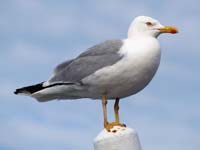
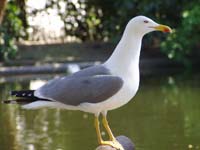
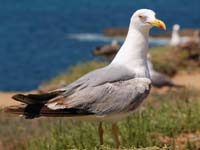
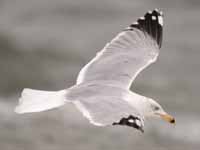

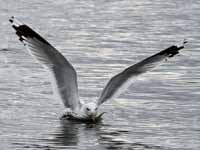
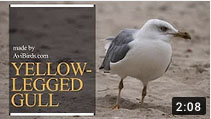
Genus Leucophaeus
New World gulls. All have white crescents above and below the eyes.
Gull,_Dolphin Leucophaeus scoresbii Found: South America
The breeding Dolphin gull has dark grey back and wing-tops, light grey underparts, light grey head, neck, white tail, red legs, red bill, light eyes. Flight feathers have white tips. Nonbreeding adult has darker grey head. Juvenile has grey hood.
Image by: 1) Charlie Westerinen - Ushuaia, Argentina 2, 6, 7)
Claudio D. Timm - Argentina
3, 8) D. Faulkner - Falkland Islands 4, 5) Nick Athanas 7) Liam Quinn - Argentina 9) Nik_Borrow - Falkland Islands1) First cycle plumage
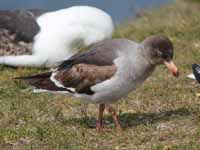
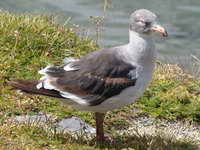
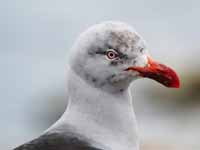
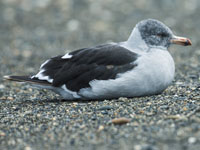
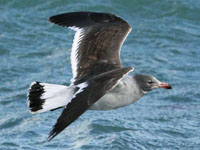
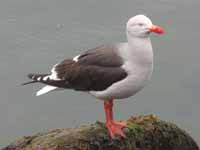
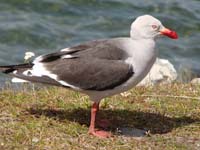
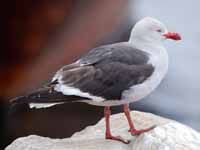
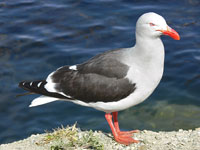
Gull,_Franklin's Leucophaeus pipixcan Found: west-central North America, Pacific coast S. America. Vagrant: Europe, Africa, Australia
The breeding Franklin gull has grey back, grey wing-tops with white trailing edges and black ends, white underparts, neck, tail, black hooded head, reddish-black legs and bill, white eye-crescents. Some primary wing feathers have white spots (mirrors) at tips. Nonbreeding adult has white head with substantial residual black hood.
Similar to: Laughing gull. Breeding Laughing gull has more complete cap than breeding Franklin's gull. Laughing gull has more black on underside wing tip than Franklin's gull. Nonbreeding Franklin's gull has more black on head than nonbreeding Laughing gull.
Image by: 1) aberlin2009 2) Johaan du Preez - South Africa 3) Leppyone - Florida
4) Aviceda - SE Queensland, Australia 5, 6) Kaleomokuokanalu - HawaiiSimilar to: Laughing gull. Breeding Laughing gull has more complete cap than breeding Franklin's gull. Laughing gull has more black on underside wing tip than Franklin's gull. Nonbreeding Franklin's gull has more black on head than nonbreeding Laughing gull.
1, 2) Juvenile 3) Adult, nonbreeding 4 - 6) Adult, breeding
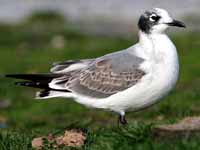

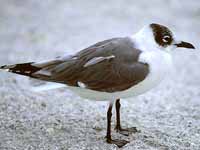
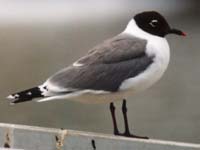
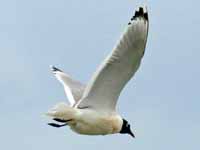
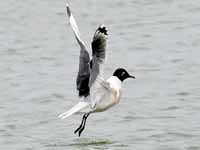
Gull,_grey Leucophaeus modestus Found: Mexico (rare), Pacific coast of South America
The grey gull has grey upperparts and lower parts, light grey head.
Image by: 1, 2) Nick Athanas - Peru, Ecuador 3) Luc Bettinelli 4, 5) Dick Daniels - Chile1) Juvenile 5) Grary gull with Whimbrel

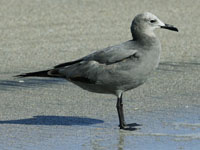
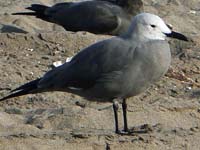
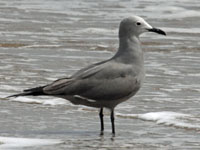

Gull,_Laughing Leucophaeus atricilla Found: The Americas, Australia Vagrant: Europe, Africa
The breeding Laughing gull has grey back, grey wing-tops with white trailing edges and black ends, white underparts, neck, tail, black hooded head, reddish-black legs and bill, white eye-crescents. Nonbreeding adult has mostly white head with some residual black.
Similar to: Franklin's gull. Breeding Laughing gull has more complete cap than breeding Franklin's gull. Laughing gull has more black on underside wing tip than Franklin's gull. Nonbreeding Franklin's gull has more black on head than nonbreeding Laughing gull.
Image by: 1, 5, 7, 8, 9, 10, 11) Dick Daniels - North Carolina 2, 3, 4, 6) Dick - Panama 12) Thomas Redican - TexasSimilar to: Franklin's gull. Breeding Laughing gull has more complete cap than breeding Franklin's gull. Laughing gull has more black on underside wing tip than Franklin's gull. Nonbreeding Franklin's gull has more black on head than nonbreeding Laughing gull.
1, 2) Juvenile 3) 2nd winter 4, 5, 6) Nonbreeding 7 - 12) Breeding

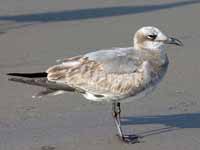


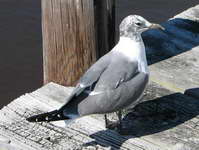

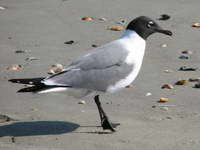
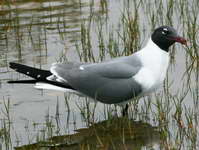
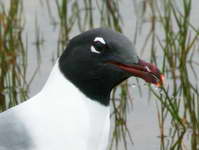
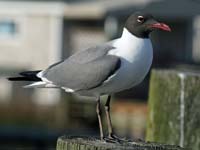
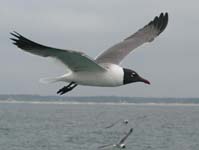
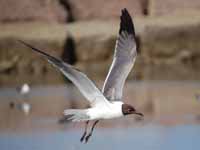
Gull,_Lava Leucophaeus fuliginosus Found: Galapagos Islands. Rare.
The Lava gull has grey body, black head, bill, legs, lighter grey underparts, white eye crescents.
Image by: 1, 2, 3) Dick Daniels - Santa Cruz Island
of the Galapagos 4) Nick Athanas - Santa Cruz Island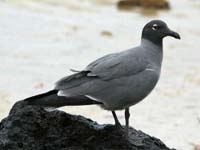
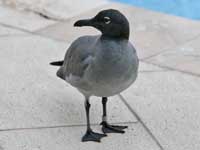
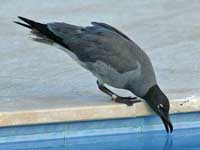
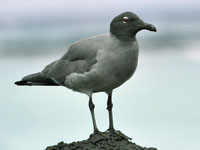
Genus Pagophila - 1 species
Gull,_Ivory Pagophila eburnea Found: circumpolar, including North America
The Ivory gull has white body, black eye and legs, greyish-green bill with yellow or red tip.
Image by: 1) US Fish and Wildlife Service - Anchorage, Alaska 2, 3, 4)
Alan Vernon - California1) Juvenile

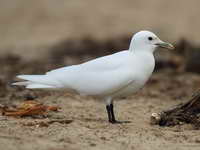
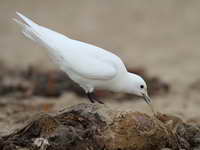
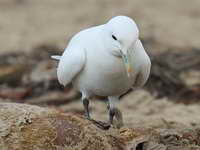
Genus Rhodostethia - 1 species
Gull,_Ross's Rhodostethia rosea Found: north North America, Europe
The breeding Ross's gull has light grey back and wings, white underparts, head, tail, white neck with black ring, red legs, black bill. Nonbreeding adult has residual black mark on neck, but no neck ring.
Similar to: Little Gull, Sabine's gull. Breeding adult Ross's gull has black ring around neck, breeding adult Little gull and breeding adult Sabine's gull have black cap.
Image by: 1) Unknown 2)
Seabaminum - New York 3) John Breitsch - Colorado 4) Dominic Sherony - Manitoba Similar to: Little Gull, Sabine's gull. Breeding adult Ross's gull has black ring around neck, breeding adult Little gull and breeding adult Sabine's gull have black cap.
1) Juvenile 2, 3) Nonbreeding 4) Breeding
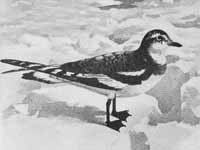
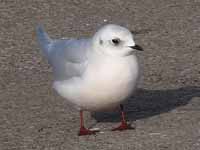
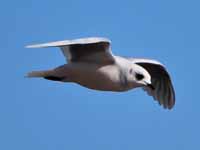
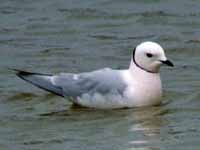
Genus Rissa
Kittiwakes are the only gulls that nest on cliffs.
Kittiwake, Black-legged also Kittiwake Rissa tridactyla Found: North America, Europe, Asia, Africa, South America
The Black-legged Kittiwake has a white head, underparts, grey back, grey wings tipped solid black, black legs, yellow bill.
Similar to: Red-legged Kittiwake. The leg color usually differentiates between Black-legged and Red-legged Kittwakes, but sometimes a Black-legged Kittiwake can have reddish legs.
Image by: 1) Seabamirum - Massachusetts 2) Bill Bouton - California 3, 4, 5) Dick Daniels - Seward, Alaska
6, 7) Dick - Homer, Alaska 8, 9) Dick - Scotland Similar to: Red-legged Kittiwake. The leg color usually differentiates between Black-legged and Red-legged Kittwakes, but sometimes a Black-legged Kittiwake can have reddish legs.
1, 2) Juvenile 3, 4) Nonbreeding 5 - 9) Breeding
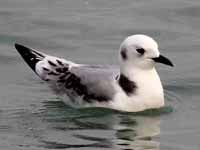
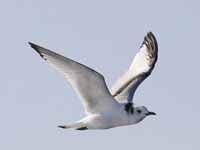
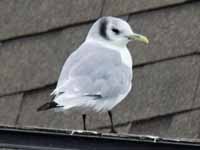
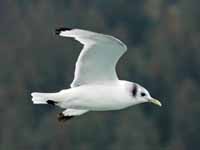


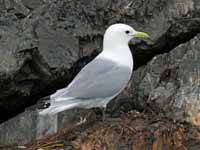
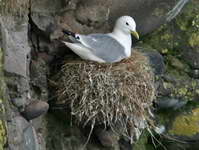
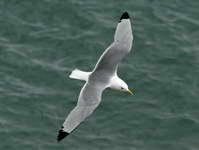
Kittiwake, Red-legged also Kittiwake Rissa brevirostris Found: west North America, Asia
The Red-legged Kittiwake has a white head, underparts, grey back, grey wings tipped solid black, red legs, yellow bill.
Similar to: Black-legged Kittiwake. The leg color usually differentiates between Black-legged and Red-legged Kittwakes, but sometimes a Black-legged Kittiwake can have reddish legs.
Image by: 1, 2, 3) Dick Daniels - Alaska Sea Life Center in Seward 4) Nic MclPhee - SewardSimilar to: Black-legged Kittiwake. The leg color usually differentiates between Black-legged and Red-legged Kittwakes, but sometimes a Black-legged Kittiwake can have reddish legs.

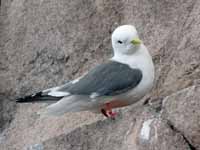
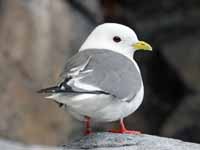
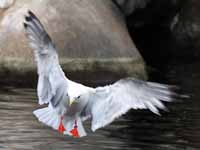
Genus Saundersilarus - 1 species
Gull,_ Saunder's Saundersilarus saundersi also Chroicocephalus saundersi Found: Asia
The Saunder's gull is very small. Breeding has black hood, pale grey back, wings, narrow black tail band, short black legs. Nonbreeding has mottled grey hood.
Image by: 1, 2) Charles Lam - Hong Kong1) Nonbreeding 2) Breeding
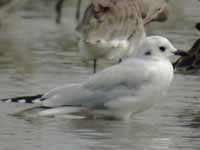
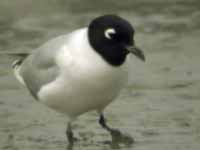
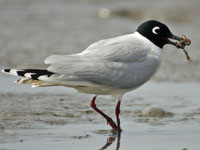
Genus Xema - 1 species
Gull,_Sabine's Xema sabini Found: North America, South America, Europe, Asia, Africa, Australia (vagrant)
The adult Sabine's gull has a pale grey back and wing coverts, black primary flight feathers and white secondaries, white forked tail, black bill with yellow tip. The male's hood darkens during breeding season.
Similar to: Little gull. Little gull is the smallest gull. Adult Little gull and adult Sabine's have dark hoods, but only adult Sabine's has yellow tipped bill. The black and white wing pattern of Sabine's gull is more distinct than Little gull's.
Similar to: Ross's gull. Adult Little gull and adult Sabine's have dark hoods, but only adult Sabine's has yellow tipped bill. The black and white wing pattern of Sabine's gull is more distinct than Little gull's.
Image by: 1) Amy McAndrew - Mexico 2) Lawrie Phipps - United Kingdom 3) Greg Schechter - California 4) Blake Matheson - California 5) Jerry Oldenettel - California 6, 7) Ómar Runólfsson - Iceland Similar to: Little gull. Little gull is the smallest gull. Adult Little gull and adult Sabine's have dark hoods, but only adult Sabine's has yellow tipped bill. The black and white wing pattern of Sabine's gull is more distinct than Little gull's.
Similar to: Ross's gull. Adult Little gull and adult Sabine's have dark hoods, but only adult Sabine's has yellow tipped bill. The black and white wing pattern of Sabine's gull is more distinct than Little gull's.
1, 2, 3) Juvenile 4) Nonbreeding 5, 6, 7) Breeding
